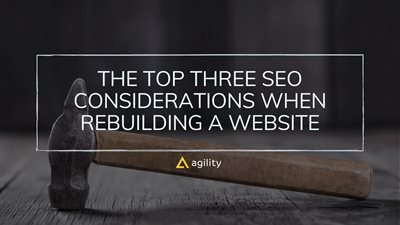What’s Orphaned Content?


To rank content, Google needs to know about it. Some other piece of content has to link to it to make it possible. Google follows these links and saves every post or page it finds through different links. That’s why adding contextual internal links to your blog content is so important.
This sounds simple on the surface. However, linking to other content may not always be your topline priority if you publish lots of content. With time, this becomes less and less important, and you start losing rankings. Only when you see a massive drop in traffic, do you become aware of the massive hole in your content strategy.
You can avoid this with the help of internal linking and making sure there’s no orphaned content.
Agility, for instance, publishes dozens of new articles every month.
And therein lies the problem of orphaned content—a high content publishing frequency.
What is Orphaned Content?
Orphaned content is any content that didn’t get links from other posts or pages on the same website. Due to this, the content is challenging to discover for both Google and visitors to the site. Orphaned content is defined as content that has no other pages on the same website linking to it.
It’s defined as content the website owner doesn’t deem valuable enough to refer it through their internal linking.
Most of us forget about past content. This is especially true if we are focused on publishing loads of new fresh content regularly. Let’s say you run a customer service-focused blog. You publish dozens of FAQ pieces and other helpful content regularly. But it’s quite hard for you to focus on all this new content and build links to it contextually.
Posts and pages make use of internal links to fit them inside a site’s structure and make them easy to discover. Here links mean contextual links. If a post or page is linked from the homepage, sitemap, category, or tag pages, it’s still orphaned content. Textual links provide both value and meaning to links.
Orphaned Content, Why are we Bothered?
If you have content on your site that you’re not building links to, you are losing valuable real estate.
Google ranks pages for particular keywords by looking at different factors like trust and authority.
When it crawls our pages, we want Google to consume as much content as it can. We don’t want to interfere in the way of quality signals.
The first step is to check if the content is of low quality and then review it to understand if we need to redirect, remove or work on reviving the said piece of content.
Why Does Orphaned Content Affect Your SEO?
To rank your content, Google needs to know about it. Search engines follow links and save the content they discover on their index. Orphaned content has few links from similar posts or pages.
Since search engines follow links and save the content they find on pages to their index, they find it hard to index orphaned content. Orphaned content has very few meaningful links from other pages or posts. That’s why Google considers this content less important than something with loads of links. Not only do you need to write quality content, but you also need to connect it with your other articles for better SEO optimization.
How is Orphaned Content Created?
If you write a new piece of content, publish this content, and then forget about it, you’re probably not going to add links to it from other pages or posts. It’s bad if you want people and search engines to find these posts.
That’s how you end up with orphaned content.
Disadvantages
- Pages with high-ranking potential that aren’t linked from the site structure are highly unlikely to be discovered and indexed and provide expected benefits like organic traffic.
- Low-quality orphan pages may be crawled and indexed due to backlinks from other sites. This would lead to a waste of your site’s crawl budget.
- Orphan pages are so many; addressing them isn’t always simple or straightforward.
In this article, I will explain how various types of orphan pages impact your SEO, an essential part of digital marketing. The guide explains how you can discover orphan pages on your site and what to do to address them.
How do Orphan Pages Affect Search Engines?
The sheer lack of internal links negatively affects how search engine crawlers discover content on your site.
- Search engines either follow internal or external links to URLs on your site
- They examine XML sitemap files
Orphan pages may be included in the sitemap or have links from other domains. They are still considered orphan pages, but their odds of getting crawled and indexed increase.
Google can index URLs found in a sitemap it will still struggle to determine the hierarchy for the page and two struggle to see it as adding any value.
This causes orphan pages to be out of the index, and they don’t rank on Google driving zero organic traffic to your site.
If an orphan page gets indexed due to other factors, page rank doesn't flow to the orphan page.
With zero internal links, search engines lack the proper semantic or structural context for evaluating the page. Search engines also struggle to determine which queries the page is relevant for and how it fits into your overall site structure.
If you have low-quality orphan pages and the crawling isn’t restricted by robots.txt or noindex tags, search engines waste the crawl budget on them. This is detrimental if you have a large site that suffers from crawl budget issues.
Low-quality pages can also result in index bloat, where the pages on a domain are indexed uncontrollably, indexing everything it finds, including thin content. This is a strict no-no if you want your actual content to be indexed on search engines and attract real users.
If a page isn’t valuable to be indexed, that can prevent other pages on your site from getting indexed too.
What is Orphaned Content in WordPress? What's the Issue With This Approach?
Finding and fixing orphaned content is a common struggle for many WordPress website owners and administrators. Orphaned content refers to pages, posts, or other types of content that exist on the website but are not linked to from any other pages or menus. These pieces of content can become lost or forgotten, making it difficult for users to access them and for search engines to properly index them.
The problem with orphaned content is that it can negatively impact a website's SEO performance, as search engines may not be able to crawl or index the content properly. Additionally, it can create a frustrating user experience for visitors who may stumble upon a piece of content that they cannot navigate to or find related content.
WordPress users often struggle to find orphaned content because the platform does not have built-in tools to identify these pieces of content. This means that website owners and administrators must manually search for orphaned content, which can be time-consuming and challenging, especially for larger websites with extensive content libraries.
Even if orphaned content is identified, fixing the issue can be challenging on WordPress. Users must navigate through the platform's menus and settings to find the correct page or post and update its links or add it to relevant menus. This process can be cumbersome and prone to errors, leading to frustration and potential mistakes.
These struggles with finding and fixing orphaned content are driving many businesses to switch to headless CMS platforms. Unlike WordPress, headless CMS platforms provide powerful tools for content management, including built-in features for identifying and managing orphaned content. These platforms also provide a more flexible architecture, allowing users to decouple the content management and delivery layers, resulting in a more agile and efficient development process.
How do Orphan Pages Affect Users?
Orphan pages cause problems for users as well. Firstly, it leads to a poor user experience for many users.
If orphan pages have quality content that drives traffic to your site, it should result in conversions. Users will face some difficulty in finding them if they’re not present in your site’s structure.
This also leads to a waste of time and resources for both parties. This time could have been otherwise dedicated to creating the content on those pages.
However, it is an entirely different scenario if those orphan pages weren’t purposefully linked, but they still remain easy for users to find.
Common Causes of Orphan Pages
Common causes of orphan pages include:
- A site migration — this happens when some old pages aren’t included within the new main navigation and aren’t redirected to the new page
- Unoptimized site architecture, where some pages aren’t linked because the site lacks proper architecture. There could also be flawed site mechanisms that prevent including new types of pages in the navigation.
- Again, pages become outdated or irrelevant when links to them are removed, but the pages remain published.
- It could also occur with out-of-stock products that no longer need active links.
- Add no links to pages, for example, for promotional or paid campaigns
Discover which pages are getting accessed
Once you have a list of your crawlable pages, you need to find pages that get visited by users or crawlers.
Prevention is better than cure.
If you want to prevent content from being orphaned, you need to ensure you build links to that content. Linking to it from other places on your site helps both users and Google find it.
Linking to the post from articles that generate traffic on search engines boost search engine visibility of the content even more.
But you need to be mindful of internal linking practices. Keep the internal links relevant.
What is more, recent UX statistics say that users crave well-organized web pages: companies with good UX achieve an 83% conversion lift in conversions and the ROI on UX investments is 9,900%. So if you want to get more links from other domains, it's important to ensure that your content is high-quality in terms of text and visuals.
Where Can I Find My Orphaned Content?
Scrolling through your list of orphaned articles can make you very aware that the most recent articles are often orphaned. All articles are important for SEO.
How to Avoid Orphaned Content
It is imperative to create great content, but you should also ensure that people see your content.
If you do certain SEO checks before your content goes online, ensure that you add internal linking to the checklist.
Search for relevant blog posts that you can add links to.
You can also go back and fix orphaned content and put that on your SEO to-do list.
Add links to blog posts with the highest traffic and ensure the authority is passed on.
Keep your internal links relevant, and don’t stuff every blog post with internal links.
The Rules for Creating Effective Anchor Texts
As mentioned earlier, contextual links are important to ensure that the content on your site isn’t orphaned. But there are also rules to follow to fix orphaned content.
Anchor texts refer to clickable text that’s used for the link, and you should always think this through.
The Google Penguin update, released first in 2012, made sure that a website that uses over-optimized anchor text is penalized.
That’s why ensure the anchor text describes the page it is pointing to.
However, you may not always be right in your attempt to use keyword-rich exact-match phrases.
Use a healthy mix of different anchors. Use phrases like click here and keep the balance healthy.
Should You Always Fix Orphaned Content?
For some articles fixing orphaned status is important. Some blog posts are only important for a short while, like news articles or product updates. Announcing these events makes for a great post but doesn’t serve much purpose afterward.
You should consider deleting the pages after the event is over.
Conclusion
It’s easy to create orphaned content unknowingly. If you’re writing so many posts, some always manage to slip through the crack and sit orphaned on your site.

About the Author
George is a writer and blogger and has been working in the SaaS and online marketing industry for the past 12 years.



